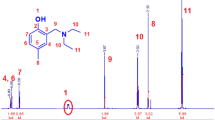Abstract
New graft copolymer hydrogels based on sodium acrylate, acrylamide, and styryl-terminated poly(2-cyclopropyl-2-oxazoline) macromonomer (MM) were synthetized by free radical polymerization using N,N′-methylenebisacrylamide as cross-linker. The polymerization was carried out in water at 5 °C and was initiated by sodium peroxodisulfate/N,N,N′,N′-tetramethylethylenediamine. The MM and the hydrogels were characterized by NMR and FTIR spectroscopy. In the hydrogels, the sodium acrylate provided the sensitivity to changes in pH value while the MM provided sensitivity to temperature. In dependence of their composition, the bi-sensitive hydrogels showed conformational transitions with variation of temperature or pH value. This property was shown macroscopically as a hydrogel volume contraction or expansion as it was determined by swelling experiments in water at different pH values and temperatures. Due to phase separation within the hydrogels facilitated by the graft copolymer network structure, both sensitivities could be addressed individually by both triggers and defined swelling states could be addressed over a wide range by adjusting both temperature and pH.







Similar content being viewed by others
References
Stuart M, Huck WT, Genzer J, Müller M, Ober C, Stamm M, Sukhorukov GB, Szleifer I, Tsukruk V, Urban S, Zauscher S, Luzinov I, Minko S, Winnik F (2010) Emerging applications of stimuli-responsive polymer materials. Nat Mater 9:101–113. https://doi.org/10.1038/nmat2614
Koetting MC, Peters JT, Steichen SD, Peppas NA (2015) Stimulus-responsive hydrogels: theory, modern advances, and applications. Mater Sci Eng R Rep 93:1–49. https://doi.org/10.1016/j.mser.2015.04.001
Gil E, Hudson SM (2004) Stimuli-reponsive polymers and their bioconjugates. Prog Polym Sci 29:1173–1222. https://doi.org/10.1016/j.progpolymsci.2004.08.003
Weber C, Hoogenboom R, Schubert U (2012) Temperature responsive bio-compatible polymers based on poly (ethylene oxide) and poly(2-oxazoline)s. Prog Polym Sci 37:686–714. https://doi.org/10.1016/j.progpolymsci.2011.10.002
Schild HG (1992) Poly(N-isopropylacrylamide): experiment, theory and application. Prog Polym Sci 17:63–249. https://doi.org/10.1016/0079-6700(92)90023-R
Richter A (2009) Hydrogels for actuators. In: Gerlach G, Arndt KF (eds) Hydrogel sensors and actuators. Chapter 7. Springer, Berlin
Langer R, Tirrell DA (2004) Designing materials for biology and medicine. Nature 428:487–492. https://doi.org/10.1038/nature02388
Dimitrov I, Trzebicka B, Müller A, Dworak A, Tsvetanov C (2007) Thermosensitive water-soluble copolymers with doubly responsive reversibly interacting entities. Prog Polym Sci 32:1275–1343. https://doi.org/10.1016/j.progpolymsci.2007.07.001
Rueda JC, Zschoche S, Komber H, Schmaljohann D, Voit B (2005) Synthesis and characterization of thermoresponsive graft copolymers of NIPAAm and 2-alkyl-2-oxazolines by the “grafting from” method. Macromolecules 38:7330–7336. https://doi.org/10.1021/ma050570p
Park JS, Kataoka K (2007) Comprehensive and accurate control of thermosensitivity of poly(2-alkyl-2-oxazoline)s via well-defined gradient or random copolymerization. Macromolecules 40:3599–3609. https://doi.org/10.1021/ma0701181
Bloksma MM, Weber C, Perevyazko IY, Kuse A, Baumgärtel A, Vollrath A, Hoogenboom R, Schubert US (2011) Poly(2-cyclopropyl-2-oxazoline): from rate acceleration by cyclopropyl to thermoresponsive properties. Macromolecules 44:4057–4064. https://doi.org/10.1021/ma200514n
Hoogenboom R, Schlaad H (2017) Thermoresponsive poly(2-oxazoline)s, polypeptoids, and polypeptides. Polym Chem 8:24–40. https://doi.org/10.1039/C6PY01320A
Diehl C, Cernoch P, Zenke I, Runge H, Pitschke R, Hartmann J, Tierschc B, Schlaad H (2010) Mechanistic study of the phase separation/crystallization process of poly(2-isopropyl-2-oxazoline) in hot water. Soft Matter 6:3784–3788. https://doi.org/10.1039/c0sm00114g
Aoi K, Okada M (1996) Polymerization of oxazolines. Prog Polym Sci 21:151–208. https://doi.org/10.1016/0079-6700(95)00020-8
Hoogenboom R, Fijten MWM, Schubert US (2004) Parallel kinetic investigation of 2-oxazoline polymerizations with different initiators as basis for designed copolymer synthesis. J Polym Sci Part A Polym Chem 42:1830–1840. https://doi.org/10.1002/pola.20024
Verbraeken B, Monnery B, Lava K, Hoogenboom R (2017) The chemistry of poly(2-oxazoline)s. Eur Polym J 88:451–469. https://doi.org/10.1016/j.eurpolymj.2016.11.016
Rueda JC, Campos E, Komber H, Zschoche S, Häussler L, Voit B (2014) Synthesis and characterization of new pH- and thermo-responsive hydrogels based on N-isopropylacrylamide and 2-oxazolines. Des Monomers Polym 17:208–216. https://doi.org/10.1080/15685551.2013.840471
Kuckling D (2009) Responsive hydrogel layers—from synthesis to applications. Colloid Polym Sci 287:881–891. https://doi.org/10.1007/s00396-009-2060-x
Krause AT, Zschoche Z, Rohn M, Hempel C, Richter A, Appelhans D, Voit B (2016) Swelling behavior of bisensitive IPNs for microfluidic applications. Soft Matter 12:5529–5536. https://doi.org/10.1039/C6SM00720A
Richter A, Kuckling D, Howitz S, Gehring T, Arndt KF (2003) Electronically controllable microvalves based on smart hydrogels: magnitudes and potential applications. J Microelectromech Syst 12:748–753. https://doi.org/10.1109/JMEMS.2003.817898
Gräfe D, Erdmann T, Richter A, Appelhans D, Voit B (2017) Tetra-sensitive graft copolymer gels as chemomechanical valve. ACS Appl Mater Interfaces 9:7565–7576. https://doi.org/10.1021/acsami.6b14931
Witte H, Seeliger W (1974) Cyclische Imidsäureester aus Nitrilen und Aminoalkoholen. Liebigs Ann Chem. https://doi.org/10.1002/jlac.197419740615
Feng XD, Guo XQ, Qiu KY (1988) Study of the initiation mechanism of the vinyl polymerization with the system persulfate/N, N, N′, N′-tetramethylethylendiamine. Makromol Chemie 189:77–83. https://doi.org/10.1002/macp.1988.021890108
Nuño-DonLucas S, Rhoton AI, Crona-Galvan S, Puig JE, Kaler EW (1993) Emulsion copolymerization of styrene and sodium acrylate. Polym Bull 30:207–214. https://doi.org/10.1007/BF00296851
Minsk LM, Kotlarchik C, Meyer GN (1973) Copolymerization of acrylamide and styrene II. Reactivity ratios with unperturbed acrylamide. J Polym Sci Polym Chem Ed 11:3037–3130. https://doi.org/10.1002/pol.1973.170111201
Weber C, Becer CR, Guenther W, Hoogenboom R, Schubert US (2019) Dual responsive methacrylic acid and oligo(2-ethyl-2-oxazoline) containing graft copolymers. Macromolecules 43:160–167. https://doi.org/10.1021/ma902014q
Acknowledgements
The authors thank Dr. M. Malanin (IPF Dresden) for the ATR-FTIR measurements on the hydrogels. J. C. R. and C. S. gratefully acknowledge the Deutschen Akademischen Austauschdienst (DAAD), the Pontifical Catholic University of Peru (PUCP), and the National Council of Science, Technology and Technological Innovation of Peru (CONCYTEC) for financial support.
Author information
Authors and Affiliations
Corresponding author
Additional information
Publisher's Note
Springer Nature remains neutral with regard to jurisdictional claims in published maps and institutional affiliations.
Electronic supplementary material
Below is the link to the electronic supplementary material.
Rights and permissions
About this article
Cite this article
Rueda, J.C., Suárez, C., Komber, H. et al. Synthesis and characterization of pH- and thermo-responsive hydrogels based on poly(2-cyclopropyl-2-oxazoline) macromonomer, sodium acrylate, and acrylamide. Polym. Bull. 77, 5553–5565 (2020). https://doi.org/10.1007/s00289-019-03034-0
Received:
Revised:
Accepted:
Published:
Issue Date:
DOI: https://doi.org/10.1007/s00289-019-03034-0




